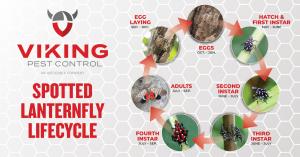Viking Pest Control Reports Twice as Many Spotted Lanternfly Calls to date in from 2024 to 2025
The Invasive, Plant-Destroying Pest is Quarantined in Every County in New Jersey
BASKING RIDGE, NJ, UNITED STATES, June 16, 2025 /EINPresswire.com/ -- Spotted Lanternflies, the invasive, plant-destroying, polka-dotted pests that have prompted a statewide quarantine in New Jersey, are once again making their presence known. Viking Pest Control’s total spotted lanternfly call volume has doubled in 2025 compared to the same time frame in 2024. That sharp increase should raise alarms for both homeowners and agricultural experts. If you think you haven’t seen any this season, you might be surprised—they're already here, just not in the form most people recognize.Why You Might Not Recognize Spotted Lanternfly Nymphs
Most people associate spotted lanternflies with their adult form—those striking black-and-red insects with spotted wings that swarm trees, porches, and backyard gardens in late summer and early fall. But long before they reach their eye-catching adult stage, lanternflies go through several nymph phases, which is what we are getting calls for this spring.
Spotted lanternfly nymphs begin their life as small, black insects with bright white polka dots and no wings. They’re often mistaken for other types of bugs or simply overlooked because of their small size. As they develop, the nymphs transition into a red and black coloration, still wingless but increasingly visible and mobile. It’s during these early stages—when most people aren’t paying close attention—that they begin feeding and causing damage.
Why It’s Critical to Stop Spotted Lanternfly Nymphs Early
While the best time to prevent lanternfly infestations is between fall and early spring—when the insects are dormant in egg masses—the current nymph stage is the next best opportunity to act. Egg masses can be scraped off trees and outdoor surfaces during the colder months, but once they’ve hatched, quick action is needed.
Nymphs, although not as destructive as adult lanternflies, still pose a risk—especially to young and vulnerable plants. They feed on the tender shoots of annuals, perennials, and garden plants, potentially stunting growth or killing off smaller vegetation. If allowed to mature, the nymphs will transform into the highly destructive adults that wreak havoc on hardwood trees, fruit trees, grapevines, and ornamental plants.
Adult lanternflies feed on plant sap using piercing mouthparts, which stresses the host plant. But the damage doesn’t stop there. As they feed, they excrete a sticky substance known as honeydew, which attracts ants and fosters the growth of sooty mold. This black fungus coats leaves and bark, blocking sunlight and further harming the plant. In vineyards, orchards, and hardwood groves, this damage can be devastating—economically and ecologically.
What You Can Do About Spotted Lanternflies Now
If you spot small, polka-dotted black or red insects hopping around your yard, garden, or trees, don’t wait—take action. Call Viking Pest Control for treatments that get spotted lanternfly nymphs under control before they can do damage to your property or spread out to do damage to trees and plants across your entire community. The earlier we respond, the better chance we have of reducing their numbers before they reach the adult stage and cause widespread damage later this year.
Eric Gunner
Viking Pest Control
+1 800-618-2847
email us here
Visit us on social media:
LinkedIn
Instagram
Facebook
YouTube
TikTok
Legal Disclaimer:
EIN Presswire provides this news content "as is" without warranty of any kind. We do not accept any responsibility or liability for the accuracy, content, images, videos, licenses, completeness, legality, or reliability of the information contained in this article. If you have any complaints or copyright issues related to this article, kindly contact the author above.
Colorado & Georgia Real Estate Professionals Launch Expansive Data Share to Help Buyers & Sellers
CAYIN Technology Launches e-Paper Integration for Sustainable Smart Displays
Military AutoSource Announces 8th Annual Operation Homeward Bound
Więcej ważnych informacji
 Jedynka Newserii
Jedynka Newserii

 Jedynka Newserii
Jedynka Newserii

Polityka

UE przyspiesza inwestycje w obronność i bezpieczeństwo. Pomagają w tym nowe narzędzia finansowe i uproszczenia dla przemysłu obronnego
Unijne inwestycje w bezpieczeństwo i przemysł obronny nabierają tempa. Strategia Gotowość 2030 zakłada integrację krajowych przemysłów obronnych państw członkowskich oraz rozwój nowych technologii w armiach. Komisja Europejska proponuje też różne możliwości zwiększenia finansowania wydatków obronnych. – Unia Europejska postawiła na bezpieczeństwo nie tylko w wymiarze deklaracji, ale też konkretnych programów – podkreśla Michał Szczerba, europoseł z Platformy Obywatelskiej.
Handel
Inflacja w nadchodzących miesiącach będzie pozostawała w celu inflacyjnym. Pojawia się duża przestrzeń do obniżek stóp procentowych

Inflacja już znajduje się w paśmie dopuszczalnych odchyleń od celu inflacyjnego i wszystko wskazuje na to, że pozostanie w nim przez dłuższy czas. Rada Polityki Pieniężnej również ma tego świadomość. Dlatego w czasie najbliższych posiedzeń powinny się pojawić obniżki stóp procentowych. Zdaniem ekonomisty dr. Jarosława Janeckiego rozsądnym poziomem głównej stopy procentowej byłby poziom 3,5–4 proc., czyli można się spodziewać obniżek o 100–150 punktów bazowych.
Nauka
Pomiar dokładnej liczby ludności pozostaje dużym wyzwaniem. W erze migracji wymaga to nowych narzędzi i definicji

Dokładne i porównywalne dane na temat ludności są niezbędne m.in. do celów statystycznych i administracyjnych. Dlatego rośnie zapotrzebowanie na statystyki z zakresu demografii, migracji, starzenia się społeczeństwa oraz dane regionalne i lokalne. Państwa Unii Europejskiej odchodzą od „tradycyjnego” spisu przeprowadzanego co 10 lat w kierunku wykorzystania danych ze źródeł administracyjnych. Przyszłością jest wykorzystanie w pomiarze danych z mediów społecznościowych czy sieci komórkowych.
Partner serwisu
Szkolenia

Akademia Newserii
Akademia Newserii to projekt, w ramach którego najlepsi polscy dziennikarze biznesowi, giełdowi oraz lifestylowi, a także szkoleniowcy z wieloletnim doświadczeniem dzielą się swoją wiedzą nt. pracy z mediami.









.gif)

 |
| |
| |
|